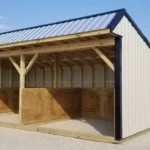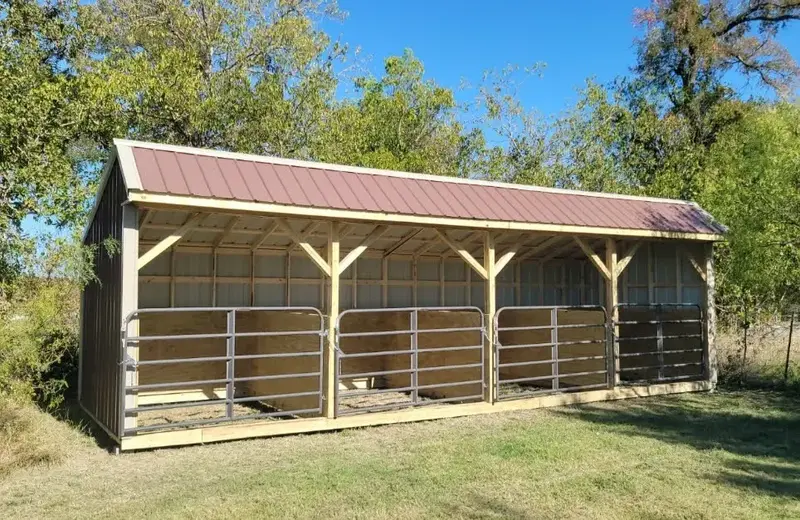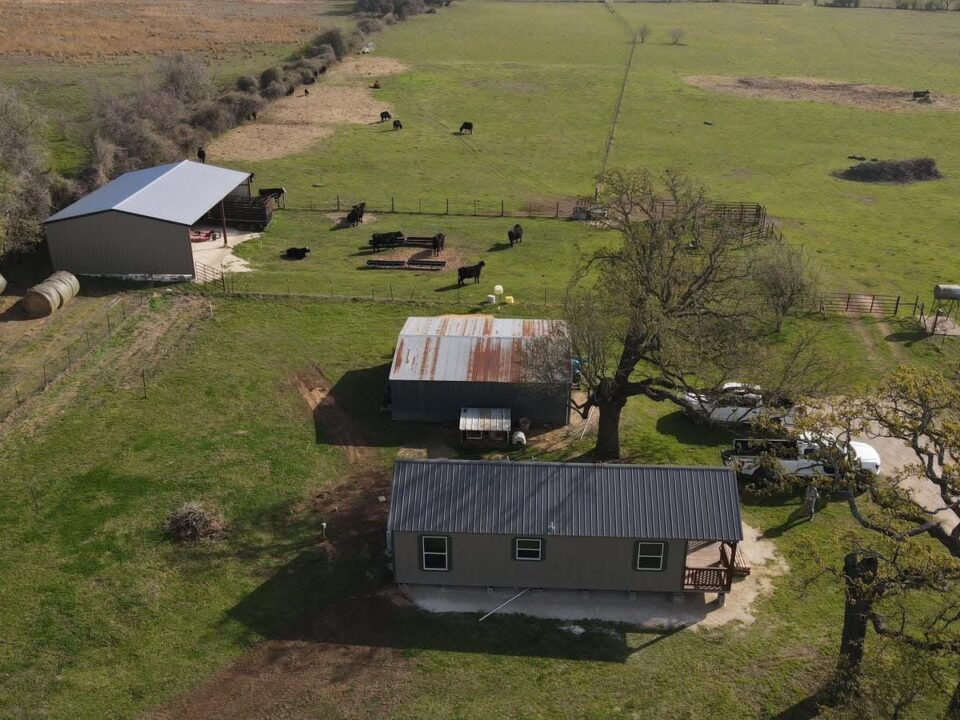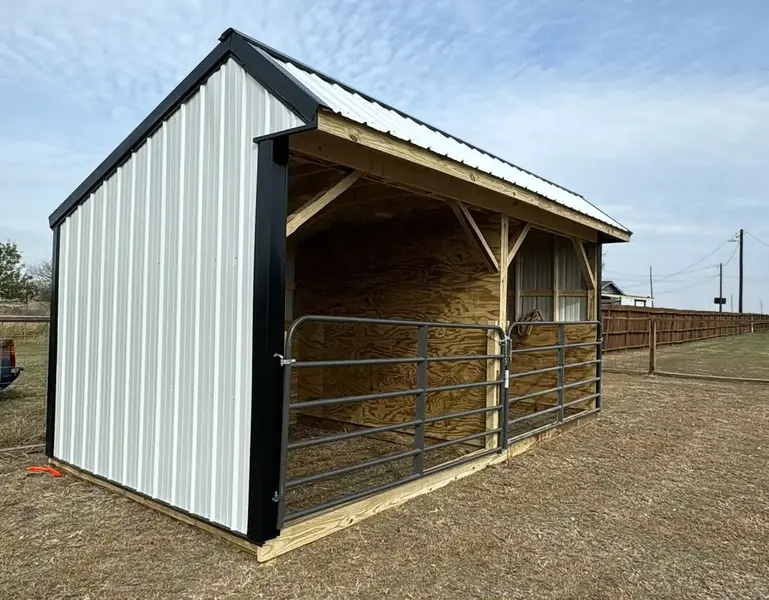
Why Wolf Valley Animal Shelters Are Built to Last
July 22, 2025
Feeding Troughs for Loafing Sheds: Complete Setup Guide
July 24, 2025Multi-Species Shelter Tips: Keeping All Your Critters Happy Under One Roof 🏠🐄🐴
So you’re thinking about housing different animals together? Smart move! Getting multiple species to share a shelter peacefully isn’t rocket science, but there are definitely some tricks to a multi-species shelter, making it work well. Whether you’ve got cattle, horses, goats, sheep, or a mix of everything, the right setup can make your life easier while keeping your animals comfortable and healthy.
At Wolf Valley Buildings, we’ve built shelters over the years, and we’ve learned what works (and what definitely doesn’t!). Let’s dive into what actually works out there in the real world.
Getting Different Animals to Play Nice Together 🤝
Here’s the thing about mixing animals – some combinations work like peanut butter and jelly, while others are more like oil and water. Cattle and horses? They usually get along just fine since they’re about the same size and don’t stress each other out too much. But throw some goats into the mix with your big guys, and you might need to think about giving the smaller critters their own space or at least some escape routes.
The biggest issue you’ll run into is size differences. A 1,200-pound cow doesn’t mean any harm, but she can accidentally step on or push around a goat without even realizing it. That’s why smart farmers create different zones in their shelters – maybe some moveable panels that let you separate species when needed, but still keep things flexible.
Building It Right From the Start 📐
Don’t Skimp on Height Trust me on this one – go taller than you think you need. We’ve seen too many shelters where the horses are ducking their heads or people are constantly worried about clearance. At Wolf Valley Buildings, we typically recommend shooting for at least 12-14 feet high. Yeah, it costs a bit more upfront, but your animals (and your stress levels) will thank you later. Plus, higher ceilings mean better airflow, which is huge for keeping everyone healthy.
Doors That Actually Work Your doors need to handle your biggest animals, but they also need to be something you can actually manage every day. Most of our customers find that 10-12 foot wide doors hit that sweet spot – big enough for horses or cattle, but not so massive that you’re wrestling with them in a windstorm. And here’s a pro tip from our years of building: multiple smaller doors often work better than one giant one, especially when you want to move different groups separately.
Flooring That Makes Sense Concrete with some texture is your friend here. It’s tough enough to handle hooves, easy to clean (and believe me, you’ll be doing plenty of that), and you can always throw down rubber mats in the high-traffic spots for extra comfort. Just make sure water can drain away – standing puddles are a recipe for problems you don’t want to deal with.
Getting the Air Moving Right 💨
Good airflow isn’t just nice to have – it’s absolutely critical when you’ve got different types of animals sharing space. Everyone produces heat and moisture at different rates, and poor ventilation can turn your shelter into a breeding ground for respiratory problems faster than you’d believe.
Natural ventilation is usually your best bet and easiest on the wallet. Ridge vents at the top, some openings along the sides, and maybe some curtains you can adjust – that’s often all you need. A good rule of thumb is about one square foot of ridge opening for every 100 square feet of floor space, but don’t stress too much about getting it perfect.
If you want to get fancy with fans, that’s fine too, but make sure you’re not blasting air directly onto your animals. Nobody likes sitting in a draft, and that includes your livestock.
Hot Weather vs. Cold Weather Summer is all about moving as much air as possible – heat stress is no joke, especially for animals that handle heat differently. Winter is trickier because you want to keep the warm air but still get rid of moisture and bad air. The key is finding that minimum ventilation rate that keeps air quality good without turning the place into an icebox.
Feeding and Watering Systems Integration 🍽️💧
Multi-species shelters need flexible feeding systems that can be adapted for different animal sizes and feeding behaviors. Removable feed bunks allow customization based on current occupants, while permanent installations should consider the height and reach requirements of various species.
Water systems must provide adequate flow rates and accessibility for all animals. Automatic waterers should be positioned at appropriate heights or feature adjustable components. Consider multiple water sources throughout the shelter to prevent competition and ensure constant access.
Feed Storage and Distribution Plan for secure feed storage within or adjacent to the shelter to streamline daily operations. Different species often require different feeds, so compartmentalized storage prevents cross-contamination and simplifies feeding routines. Install proper ventilation in feed storage areas to prevent spoilage and maintain quality.
Safety Features and Risk Management ⚠️
Multi-species environments present unique safety challenges requiring proactive planning. Smooth surfaces, rounded corners, and proper spacing prevent injuries during normal movement and feeding activities. Remove or protect any protruding objects that could cause harm to animals of different sizes.
Structural Safety Standards Use appropriate materials and construction techniques for your specific animal combinations. Heavy-duty posts and panels withstand larger animals while maintaining security for smaller ones. Regular inspections identify potential hazards before they become serious problems.
Maintenance and Management Strategies 🔧
Regular maintenance ensures long-term functionality and animal safety in multi-species environments. Daily inspections should cover structural integrity, cleanliness, and equipment functionality. Weekly deep cleaning prevents disease transmission and maintains healthy environments for all species.
Seasonal maintenance includes checking roof integrity, ventilation system functionality, and heating/cooling equipment operation. Document maintenance activities to identify patterns and predict future needs, helping budget for repairs and replacements.
Smart Money Moves and Upgrades 💰
Here’s the thing about multi-species shelters – they actually save you money compared to building separate structures for each type of animal. You’re sharing utilities, using one foundation, and getting more bang for your construction buck. Wolf Valley Buildings has helped lots of farmers maximize their investment by designing flexible spaces that can adapt as their operations grow or change.
Ready to start planning your multi-species shelter? Wolf Valley Buildings specializes in custom agricultural buildings that work for real farmers dealing with real challenges. We’d love to talk through your specific situation and help you design something that’ll work great for years to come. Give us a call or check out our website to see examples of multi-species shelters we’ve built for farms just like yours! 🌟
Internal Links:
Why Wolf Valley Animal Shelters Are Built to Last
How to Build a Shelter for Your Small Animals
Raising Chickens in TX Heat: Shelter and Summer Survival Tips




